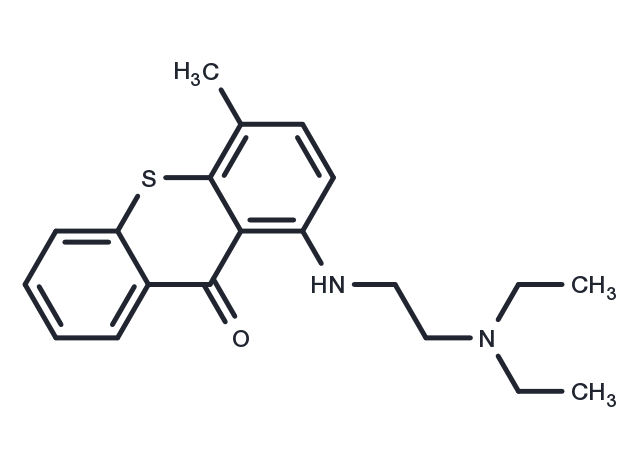Powder: -20°C for 3 years | In solvent: -80°C for 1 year


Lucanthone (Lucanthonum) is an inhibitor of Apurinic endonuclease-1 (APE-1).

| Pack Size | Availability | Price/USD | Quantity |
|---|---|---|---|
| 1 mg | In stock | $ 51.00 | |
| 2 mg | In stock | $ 73.00 | |
| 5 mg | In stock | $ 128.00 | |
| 10 mg | In stock | $ 198.00 | |
| 25 mg | In stock | $ 422.00 | |
| 50 mg | In stock | $ 623.00 | |
| 100 mg | In stock | $ 882.00 | |
| 1 mL * 10 mM (in DMSO) | In stock | $ 143.00 |


| Description | Lucanthone (Lucanthonum) is an inhibitor of Apurinic endonuclease-1 (APE-1). |
| In vitro | Lucanthone, an innovative autophagy inhibitor, induces apoptosis through cathepsin D activation and has been evaluated for its anticancer efficacy via MTT assay. Demonstrating a consistent reduction in viability across seven breast cancer cell lines, Lucanthone surpasses Chloroquine (CQ) in potency, evidenced by a significantly lower mean IC50 of 7.2 μM compared to 66 μM for CQ. Further validation through ATPlite assay and trypan blue exclusion in two representative cell lines (MDA-MB-231 and BT-20) confirms these findings. |
| Cell Research | Cell viability is assessed by MTT assay. Cells are seeded into 96-well microculture plates at 10,000 cells per well and allowed to attach for 24 h. Cells are then treated with Lucanthone (0, 0.5, 1, 5, 10, 20 and 40 μM), Chloroquine, Vorinostat, or combinations for 72 h. Following drug treatment, MTT is added and cell viability is quantified using a BioTek microplate reader. Effects on cell viability are also determined by measuring ATP levels using the ATPlite assay system and by trypan blue exclusion. Pro-apoptotic effects following in vitro drug exposure are quantified by propidium iodide (PI) staining and fluorescence-activated cell sorting (FACS) analysis of sub-G0/G1 DNA content[2] |
| Synonyms | Lucantona, Lucanthonum |
| Molecular Weight | 340.48 |
| Formula | C20H24N2OS |
| CAS No. | 479-50-5 |
Powder: -20°C for 3 years | In solvent: -80°C for 1 year
DMSO: 60 mg/mL (176.22 mM), Sonication is recommended.
You can also refer to dose conversion for different animals. More
bottom
Please see Inhibitor Handling Instructions for more frequently ask questions. Topics include: how to prepare stock solutions, how to store products, and cautions on cell-based assays & animal experiments, etc.
Lucanthone 479-50-5 Autophagy Cell Cycle/Checkpoint DNA Damage/DNA Repair DNA/RNA Synthesis Lucantona inhibit Lucanthonum Inhibitor inhibitor
